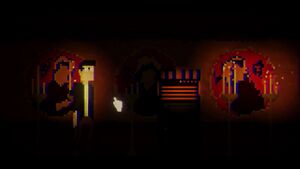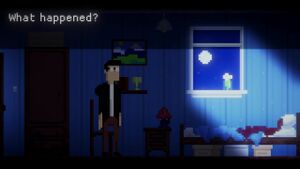Immanence
| Immanence | |
|---|---|
[[Datei: | |
| Studio | Cat In A Jar Games |
| Publisher | Cat In A Jar Games |
| Erstveröffent- lichung | 22.01.2020 |
| Genre | Adventure, Indie |
| Spielmodus | Singleplayer |
This is a game analysis for the game Immanence, written by Schrödinger inside of a bag inside of a bag.
Motivation
The first thing that appealed to us was the description of the game as a 2D psychological lovecraftian blend of religion and technology. That and the sound design made the game very interesting.
What´s special about it?
The game in itself is surprisingly difficult, as many of the minigames can´t seem to be solved purely with logical thinking. This has the potential to be quite frustrating - but even that seems to be rooted in the story the game wants to tell and makes all the more sense in retrospect, after the game has been finished. The story is the main focus of the game, at its end there are many questions left unanswered...but that just makes it even more intriguing. It's incredibly fascinating to think back to the beginning after finishing the game, to the different dimensions and what everything means. The description of the game detailing something about "religion" provides exiting context clues. Additionally, the sound design is incredibly immersive and fits perfectly with the visual style of the game.
Theme
What is the theme of the game?
Immanence is a 2D psychological Lovecraftian blend of religion and technology with surreal puzzles. It has a dark atmosphere and is very thriller-like, the mood is mysterious and dystopian. The puzzles often refer to some sort of cryptic technology and don´t seem to be rooted in logic (which makes sense only after completing the storyline). The pixel art style as well as the sound design really support the overall mood.
(tracks created by the artists Nyctophiliac, Gouldenberg, Круги под глазами).
How is the theme communicated to the player?
The theme is mainly expressed through the storyline and visual style, although there are certain limitations - such as the theme only being truly apparent when the game is completed. Everything before that acts more like puzzle pieces to the greater picture. The player first gets introduced into a seemingly normal world, with dystopian elements only gradually being introduced through sound design and occasional story pieces. Equally as important as the dystopian and futuristic references to a post-apocalyptic world is the psychological element of the game. The player witnesses the protagonist´s descent into madness and guides him through it. Neither the protagonist nor the player know what´s really going on, both are trapped within the mind of the main character.
Player Experience
The game builds a lot upon mystery and technology. At the beginning the player is thrown into an unknown reality with little to no information about the place, time or situation they´re in. The player can’t pinpoint what´s coming next - contributing to the thriller/horror mood of the game. The mystery about what happened has to be unraveled throughout the entire game. While at the beginning the game focuses more on introduction and exploration of the map, this changes when the player gets a few leads on what to do. But even then, the game focuses a lot on confusing the player. Components like sound, gameplay and visuals lead to rising tension (with for example jumpscares, effects like glitching and offsetting sound). Other than that, the game keeps its rather slow pace, which can make the player feel frustrated. Also, the puzzles are generally viewed as difficult, which can also lead to the player feeling fed up mid through.

What does the player feel? Does the experience change during the game?
The beginning of the game is rather slow, with soft and calming sound design, making it seem like a rather bland story based game. Only as the story gradually gets introduced and the general setting of the game is defined does the game get more interesting. The first minigames are relatively easy to solve, although there is always a certain element of uneasiness and uncertainty because of the nature of the game and/or story ; no one tells the player what to do, what´s supposed to happen next to progress the story. As the minigames get harder, it becomes more and more frustrating to figure out how to solve the puzzles (such as when to switch between the R, G & B dimensions and what to interact with). The sound design gets gradually more intense, the player gets more immersed. Towards the end, the story and puzzles get less dense, bringing back the uncertainty from the early stages of the game. With about an hour of playtime but no signs as to when exactly the game ends, the player grows increasingly inpatient. The story then progresses rather quickly to the ending, bringing satisfaction to the player.
What elements contribute to the experience?
Mainly the sound and level design: both are incredibly dystopian.
Story
What is the main story?
TLDR: The true story behind the game is never explicitly told. Objectively, the protagonist starts out as "normal" . Towards the end, he, his actions and the environment become increasingly bizarre. Based on the keyword "religion" in the official game description, we assume that the player accompanies the protagonist as he falls prey to (religious) madness and delusions. Thus, it's not a real (post-)apocalyptic, dystopian world where an invention called "IGME" makes people fall ill with Stigmata, but the invented, confused world of a madman. This is also reflected in the minigames (dimensions R, G, B), which cannot be solved with normal logic. We as players see the world through the distorted eyes of the protagonist. -- The plot is communicated through the thoughts of our main character when clicking on something or entering a new place. Occasionally, there´s short dialogues with other characters or standalone text.
The story is about the main character waking up alone in his apartment complex, in a ruined city. Throughout the game we find out more and more about what happened to this place and the main character. At the beginning of the story the only method of contact with the outside world he has is through his phone. He´s in contact with a doctor and also receives some seemingly random cryptic text messages. The doctor keeps wanting to help the main character, he seems worried. There are machines and other types of technology scattered all over the map, acting as communication devices. They also change reality through a god-like entity referred to as "IGME". Throughout the game, we find out that this technology was made available, affordable, and easy to recreate for the public in the past few years. Because of that, people happily bought the machines, thinking "IGME" was a god-like answer to everything. What they didn’t know was that the technology was dangerous to everyone’s health. We find out that at first, animals all over the city died due to high exposure to the frequency of the machines. Then, people began to fall ill - first mentally, then physically. They called the illness Stigmata. We find out that the main character has also fallen ill, slowly losing his ability to function. He knows he needs help and goes to a doctor. Suddenly, he gets the option to change his environment via switching through different dimensions called R, G & B on his phone. He starts to see abstract rooms and monsters. He believes that if he turns off the randomly scattered machines he stumbles across on the way to the doctor, all will be good - but in the end his illness gets the best of him, rendering him immobile.
At the end there´s a plot twist with the truth about the main character´s imminent death/his sickness being revealed to the player: In reality, the main character is experiencing hallucinations and delusions which may or may not be related/worsened by physical illness (or somatic illness). There is no "IGME". The puzzles and weird text messages are the protagonist´s brain trying to piece together random things in his mind, to make sense of something. He may or may not have had religious fixations manifesting in the religious themes of his hallucinations. It seems that in the real world, the main character has been hospitalized due to his condition while his friend (someone who comes up as a narrator a few times throughout the game) writes down his rambling about "IGME", Stigmata and the world he had imagined in his mind. In a nutshell, the whole plot and dimensions of the game were purely hallucinated by the main character, who suffers from an illness.

Games of emergence and games of progression
Immanence is a game of progression, with a clearly defined storyline that the player must follow in order to finish the game.
How is the story communicated?
Mainly through interactions with objects. Everytime the protagonist looks at something, text appears at the bottom of the screen. The protagonist also has a phone, conversing with his doctor who tells him and the player what to do.
Setting
What is the setting of the game?
Immanence takes place in a dark, mysterious, dystopian future: A city called New Jericho where all animals died simultaneously and people are affected by a sickness called Stigmata. All this seems to be related to IGME: computer-like devices which allow communication with an otherworldly, godlike being. And it seems to be getting closer.
How is the setting communicated?
At the beginning, the player moves through the protagonist’s apartment block, only learning about the outside through the main character’s remarks on certain objects and the messages on his phone. The gloomy atmosphere is created through the dilapidated look of the building, the lack of working lights as well as the unsettling music. As the player progresses through the game, the setting dissolves into less clear scenarios, which raise the question of whether what the character is experiencing is even real, while the base layout, being a combination of corridors, rooms, and doors, stays the same throughout.
Are there references depicted from real life?
Immanence uses lots of religious imagery, Christian and satanic symbols in particular. The IGME-machines and their development show remarkable similarities to our modern communication devices.
Characters
What or who is the protagonist of the game?
At first, the protagonist seems to be an arbitrarily chosen person in this scenario. He owns an IGME-device, a phone, a social media account, lives in a regular apartment. He also experiences symptoms of Stigmata. Like everyone else. The end of the game, however, implies this entire scenario is just what takes place in the character’s head as his mental state declines.
What are the characteristics of the characters?
Visually, the protagonist is defined by his glasses and dark hoodie. His character traits, however, are largely unknown to the player. All we know is that he is willing to help stop what is happening, but ultimately too sick to do so.
Can the player relate to the character? And if so, why?
For most of the game, the protagonist functions as a self-insert, not as a character in his own right. Still, there is a knowledge discrepancy between the player, thrust into a scenario they can’t comprehend, and the protagonist, who seems to have a basic understanding of the world he is – or imagines himself – in. Thus, the player can neither fully imagine themselves being the protagonist nor relate to him, as little is known about him or his motives. With the reveal that the game is likely taking place in the protagonist’s head, the person allegedly imagining this becomes an entity entirely separate from the player. But what is really happening to him remains speculation.
Objectives
What is the main goal of the game?
The game does not communicate any goals to the player, but it continually builds up intrigue, making the player want to find out more about the world, thus progressing while the story unfolds.
Does the game include any sub goals?
Many parts of the map are not initially accessible, solving puzzles to reach them is required. Later on the player also encounters large, red creatures which reset part of their progress on physical contact. Avoiding and/or shooting them is the only way to continue.
Procedures
How can the player carry out actions in the game?
Via point and click by mouse most of the time. There’s one sequence that is controlled with the arrow keys. The mouse will change its visuals based on interactions with the objects you’re hovering over.
-
Mouse cursors
-
Changing the environment with the RGB-modes on your smartphone
You can also change your environment with your smartphone. The only actions the character can take is, walk, inspect, interact/pick up and shoot.
How can the character be controlled?
The left mouse button and the arrow keys.
Basic Resources
What are the basic resources in the game?
The overall story of the game does not require any resources to progress. Each resource found in the game is needed to solve a specific passage or puzzle and can only be used during this event. cell phone: Early in the game the player finds a phone that enables interdimensional travel. Other than that, it also provides exposition and hints via text messages and has a playable mini game on it. top-down puzzle: In the beginning of one passage the player is given five lives , decreasing with each enemy attack. A sword and a shield can be acquired for better protection as well as healthpacks to restore lives. gun: during the final passage, the player has to defeat enemies with a gun. keys/objects/furniture: The apartment complex is old and empty. Most rooms have furniture and items in them but not many can actually be interacted with. The most frequently found items are keys. Most apartment doors are locked, some of them can be unlocked by finding and using keys.
What is the relation between the resources?
cell phone and keys: sometimes objects and keys needed in one dimension are found in another dimension. The player needs to use the travel functions on the cell phone in order to find the objects. top-down puzzle: Initially, the player has 5 lives. Enemy attacks cost 1-2 lives, it takes about 2-3 lives to defeat one enemy. A healthpack replenishes lives and adds an additional life. Swords and shields provide protection which decreases the amount of lives taken by an enemy attack.
What is the nature of the resources?
cell phone: The phone is accessible the whole time but not always useful. Though the battery icon in the upper corner is red, the battery never dies or needs to be charged otherwise. Game analysis 2 top-down puzzle: The resources can only be used in this puzzle. Each enemy attack costs lives, healthpacks can restore and give additional lives. You can get about 8-10 lives. gun: Once the player finds the gun, it is permanently in your possession. The gun’s ammunition is infinite.
Conflict
Does the game provide any conflicts?
The most common obstacles are locked doors or incomplete objects. In the top down passage and at the end of the game there are also enemies blocking the player’s path or chasing you.
What is the nature of these conficts?
The doors are locked because the apartment complex is old and empty. Some objects are only available in different dimensions because they no longer exist in the player’s home world, like flowers. It is also possible to flee to another dimension because enemies might be after you in your home world. The enemies in the top-down puzzle serve a role as guards. The most prominent opponents are the mutated monsters chasing you at the end of the game. They are the only enemies actively trying to defeat you and are probably after you because the player is one of the last existing humans.
How can the player resolve the conflicts?
Some doors can be unlocked using keys. These, as well as other objects, are found in different dimensions accessible through your phone. Not all top-down puzzle enemies need to be defeated in order to complete this passage. The player can walk by and ignore those who are not blocking any ways because they will not strike first. The first mutated monster, that the player encounters, cannot be defeated. You need to run away and travel to another dimension before it gets too close. Later, the player finds a gun and can then shoot the monsters. It takes 3 shots to take a monster down.
Outcome
What are the results of the game?
As this game is very story-driven there aren´t any quantifiable results other than completing the minigames in order to finish the storyline and catch up on the lore of the game world.
What are the victory conditiions?
This game doesn´t really have winning or losing - you can either finish the story or do nothing and enjoy listening to the game music. In the minigames, "winning" would be successfully completing a puzzle and/or jumping inbetween the R, G & B dimensions in order to advance the story.
What are the defeat conditions?
There doesn´t seem to be any consequences for not finishing the story. Near the end of the game, the protagonist goes down several hallways and is chased by monsters - if one of those monsters catches up to him, he seems to respawn in another hallway ; "losing" would mean restarting that particular game section, although the character seems to have unlimited attempts at trying with no punishment mechanism.
Visual Style
What is the visual style of the game?
2d pixel art.
Are other games referenced?
It doesn´t seem like it.
Is the art style inspired by real life?
No, it is heavily stylized.



